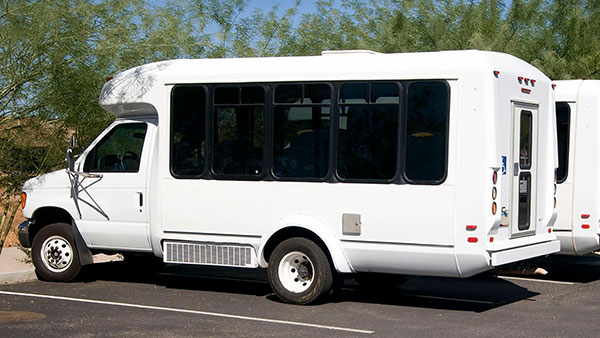When most people think about eco-friendly travel, they picture hybrid cars or electric vehicles. But, here’s something that might surprise you: Charter buses (or motorcoaches) consistently rank among the most environmentally responsible ways to move groups of people from point A to point B.
The transportation sector accounts for 29% of all greenhouse gas emissions (both direct and indirect) in the United States in 2022, according to the U.S. Environmental Protection Agency (EPA). And frankly, that’s a staggering number that’s only expected to keep growing.
However, what’s particularly interesting (and somewhat counterintuitive) is that when you crunch the numbers on emissions per passenger mile, charter buses emerge as clear winners in the sustainability game.
Charter Buses Vs. Other Modes of Transportation
A report conducted by Oxford Economics and commissioned by the American Bus Association Foundation (ABAF) found that traveling by motorcoach or charter bus is the most sustainable and energy-efficient transportation option available to people today.
“This report recognizes what our industry has long known: motorcoaches are the most energy-efficient, lowest-emission mode of passenger transportation available today,” said Fred Ferguson, president and CEO of the American Bus Association. “In 2023 alone, motorcoach travel helped the U.S. avoid an estimated $2.7 billion in social costs tied to emissions. These outcomes aren’t just statistics – they’re the result of decades of innovation, from clean idle engine technology to sustainable manufacturing practices. The motorcoach industry is proving every day that clean, connected travel is not only possible – it’s already here.”
Energy Efficiency
According to the report, the charter bus was the most energy efficient mode of transportation for travel, with only an average of 53 grams of CO2 per passenger mile. Other transportation modes, such as light rail, passenger car, and ferry boat, consumed over 100 grams and more of energy per passenger mile.
Table 1. Energy Efficiency of Different Transportation Modes (2023)
| Transportation Mode | Average Grams of CO₂ per Passenger Mile |
| Charter bus / motorcoach | 53 g |
| Vanpool | 106 g |
| Heavy rail | 116 g |
| Intercity rail | 184 g |
| Light rail | 217 g |
| Trolley bus | 218 g |
| Commuter rail | 279 g |
| Passenger car | 406 g |
| Air travel | 479 g |
| Transit bus | 547 g |
| Ferry boat | 1,392 g |
Source: ABA, Our World in Data
Social Cost of CO₂ Emissions
In addition to being energy efficient, charter buses also recorded the lowest social cost of carbon (SCC) emissions. For instance, in 2023, nearly 38 billion passenger miles were traveled by charter bus travel, which translates to $2.7 billion in environmental, health, and economic savings.
The social cost of carbon is a measure of the present value of long-term environmental, economic, and health impacts caused by each additional unit of CO₂ emissions in a year. It is used to estimate the social savings generated by each additional unit of CO₂ emissions prevented by sustainable travel choices.
Table 2. Social Cost of Carbon (SCC) of Different Transportation Modes (2023)
| Transportation Mode | Average SCC per Passenger Mile |
|---|---|
| Charter bus / motorcoach | $0.01 |
| Vanpool | $0.02 |
| Heavy rail | $0.02 |
| Intercity rail | $0.04 |
| Light rail | $0.04 |
| Trolley bus | $0.04 |
| Commuter rail | $0.06 |
| Passenger car | $0.08 |
| Air travel | $0.10 |
| Transit bus | $0.11 |
| Ferry boat | $0.28 |
Source: ABA, EPA, Our World in Data, and Tourism Economics
Clean Idle Technology
The report also highlighted how modern charter buses are equipped with advanced Clean Idle technology. Kicking in during idle periods at terminals, loading zones, and rest stops, this technology reduces idle nitrogen oxide emissions by nearly 50% below the regulatory limit of 30 grams per hour.
“… [B]y adopting cleaner fuels, improving fleet efficiency, cutting emissions, and investing in green infrastructure, the motorcoach industry has sharply reduced its carbon footprint,” director of Policy, Research & Impact at the ABAF Lew Myers said. “As regulations tighten and climate awareness grows, sustainability has become a strategic imperative for future growth and resilience.”
Beyond Carbon: The Full Environmental Picture
Emissions, energy efficiency, and clean technology represent just a portion of the environmental puzzle, though these are the most talked-about metrics. Other factors that make charter buses environmentally superior include the following:
Traffic Reduction
Traffic reduction stands out as a major benefit. One charter bus can potentially replace 36 individual vehicles on the highway, according to the United Motorcoach Association (UMA). Anyone who’s been stuck in traffic knows this isn’t just theoretical; it’s a real reduction in congestion that compounds environmental benefits.
Less traffic means reduced idle time for everyone on the road, and it means fewer parking spaces are needed at destinations. Charter bus usage significantly reduces the environmental impact of large gatherings simply through this multiplier effect.
Impact on Infrastructure
Charter buses’ impact on infrastructure deserves consideration, too. Roads, parking lots, and fuel stations all require resources to build and maintain. When fewer individual vehicles are on the road, the long-term infrastructure demands decrease proportionally.
The Mathematics of Green Transportation
Let’s break down the actual environmental impact.
A typical charter bus carries 36 passengers and achieves approximately 6 miles per gallon. Now, that fuel efficiency might sound terrible compared to your sedan, but wait. When you calculate emissions per passenger mile, the picture changes dramatically.
Charter buses produce 53 grams of CO2 per passenger mile. Compare that to other popular travel options: Commercial airlines generate 479 grams per passenger mile, while single-occupancy vehicles can produce 406 grams per passenger mile.
While a charter bus at full capacity would be ideal, even half-full buses (which happens more often than you’d think) still outperform most alternatives. A charter bus carrying just around 30 passengers still produces fewer emissions per person than individual car travel.
Making the Environmental Case for Charter Buses
The environmental benefits of charter buses become more compelling when you consider the full lifecycle impact. Manufacturing one bus instead of dozens of individual vehicles requires fewer raw materials and energy. And, with most operators maintaining a fleet, which lasts on average 10.3 years, this environmental equation is further improved.
At the end of the day, charter buses represent one of the most environmentally responsible ways to move groups of people. The combination of high passenger capacity, improving fuel efficiency, and reduced infrastructure impact creates environmental advantages that are difficult to match with other transportation modes.
For organizations serious about reducing their environmental footprint, charter bus transportation offers a practical solution that doesn’t require compromising on comfort or convenience. As environmental concerns continue driving transportation decisions, charter buses stand out as a proven, immediately available option for sustainable group travel.





